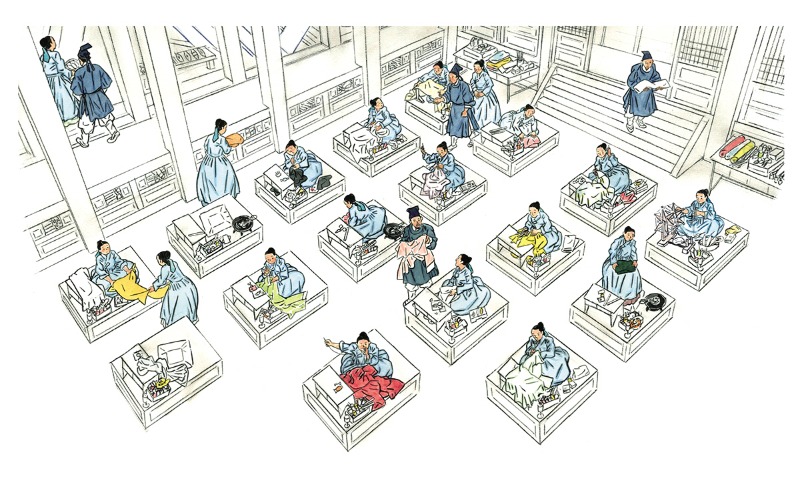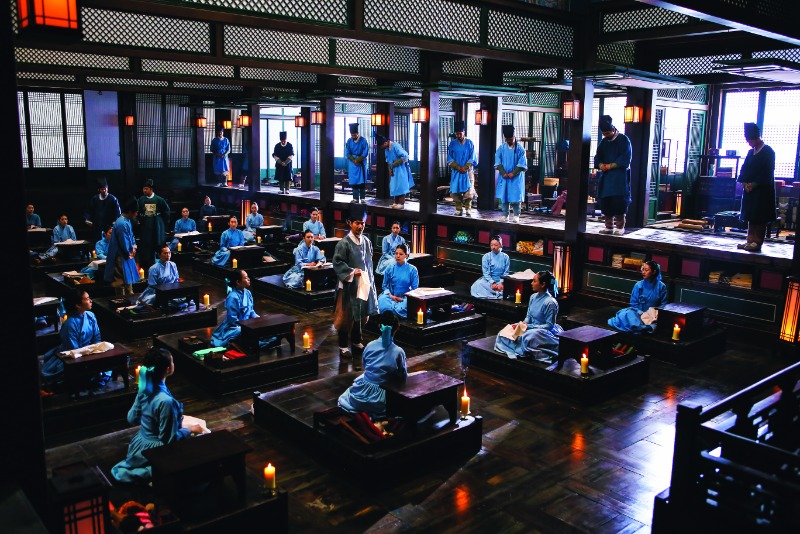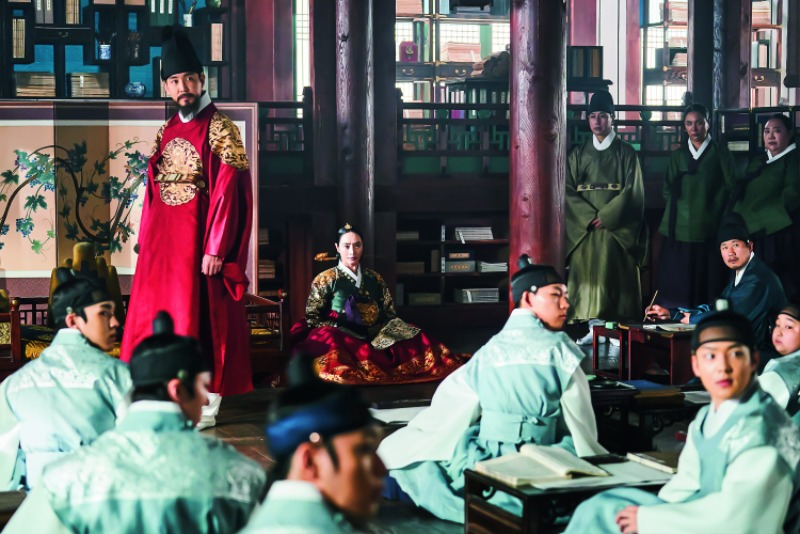Deep inside the royal palace, a cadre of workers and various institutions provided services that the king required to rule the nation and care for his family. Only the most skilled and knowledgeable individuals were brought inside the palace to meet these needs.

Artist Jang Sun-hwan’s 2014 illustration for the promotion of the film “The Royal Tailor” portrays the daily life of people working in Sanguiwon, the royal clothing bureau.
© Jang Sun-hwan
Korean historical films and dramas typically include many scenes in the royal palace where the king and his family perform their duties, with most of the personnel blending into the background. Servants, eunuchs, court ladies, and advisors are requisite cast characters, but occasionally the spotlight swings away from the familiar and focuses on those who brought unique wisdom and artistry into the palace.

Director Lee Won-suk’s “The Royal Tailor” is a captivating drama depicting an incident that may have occurred in Sanguiwon, which dressed the Joseon Dynasty’s royal families. The revealing handiwork of the palace designers and sewers framed the plot line.
© BIDANGIL PICTURES
“The Royal Tailor” is a period film that unfolds in Sanguiwon, a palace institution that made the clothing for the king and his family and oversaw some royal operations. The period thriller “The Night Owl” revolves around events in Naeuiwon, the palace’s most important medical facility. Finally, the TV series “Under the Queen’s Umbrella” showcases Sigangwon, the department assigned to educate the crown prince.
Royal Clothing Bureau
“The Royal Tailor” depicts the struggle between Jo Dol-seok, who has been working for the throne for 30 years, and Lee Gong-jin, a gifted, barely known artisan. Jo (played by veteran actor Han Suk-kyu) is the respected chief tailor of the palace, but it is the works of Lee Gong-ji, the young upstart (played by Go Soo), that capture the hearts of the royal couple and set the country’s fashion trend.
The characters and plot are fictional, but the setting of the 2014 film directed by Lee Won-seok is a government office that actually existed. Sanguiwon was tasked with producing the royal wardrobe, managing the royal treasures and seals, and even constructing the sedan chairs that carried the royal family members.
Palace records show that Sanguiwon was not divorced from administrative misgivings and extra duties. Jeongjong sillok (1426), the annals of the second king of the Joseon Dynasty, states, “Sanguiwon looks after the king’s private property and handles everything related to the clothing and ancillaries of the king. But today, the positions of this office are filled with greedy and unvirtuous people, resulting in the waste of resources. I therefore appeal to Your Majesty to appoint a fair and honest official to oversee their work.” Twenty-eight years later, Sejong sillok (1454), the annals of King Sejong, notes that Sanguiwon made the clothes and shoes worn by the participants of a grand banquet held in Geunjeongjeon, the throne hall of Gyeongbok Palace.
The importance of Sanguiwon’s duties gave it a considerable status and scale. According to Gyeongguk daejeon (1466), the “National Code” of the Joseon Dynasty, it had 11 regular officials, including two chiefs who were assisted by a deputy. All three belonged to Seungjeongwon, the royal secretariat. Therefore, the heads of the bureau had relatively high positions in Joseon’s administrative hierarchy. In addition to these 11 individuals, a large contingent of support personnel worked in the palace. Their job description was japjik, or “miscellaneous duties.”
The wardrobe of the king and his family members had to display dignity and authority, so the bureau recruited the best garment makers. Gyeongguk daejeon says that 597 individuals in 68 trades were affiliated with the bureau. The largest group were the 105 silk weavers, followed by 75 fiber bleachers. They far outnumbered the 40 sewers, 20 fabric makers, 10 straw-hat makers, 10 jade craftsmen, and 8 fur clothing makers, as well as the assortment of silver artisans and gold leafing specialists. All in all, the bureau provided an ideal workspace for artisans with outstanding skills. That may explain why King Sejong (r. 1418–1450) offered the position of byeoljwa (director) of the bureau to Jang Yeong-sil, a prominent scientist.
Royal Clinic
“The Night Owl” is set during the reign of King Injo (r. 1623–1649). It delves into the fate of Crown Prince Sohyeon, who was held hostage in Qing China after its forces successfully invaded Joseon in 1636. Upon his return after eight years, the prince sought to modernize Korea by introducing Catholicism and Western science, but he died suddenly just two months later. The movie questions the unexplained death. Poisoning is suspected, as well as the role of King Injo, who adamantly rejected his son’s notions.
The protagonist of the film, Cheon Gyeong-su (played by Ryu Jun-yeol), is a skilled medical practitioner. He catches the attention of the royal doctor, Yi Hyeong-ik (played by Choi Moo-sung), and is brought to the palace. Cheon is an imaginary character but Yi is a real historical figure, as are the king and crown prince. The mysterious death was also based on real events, with the royal doctor suspected of conspiring with Lady Jo, one of King Injo’s concubines.
The 2022 film directed by Ahn Tae-jin is set in Naeuiwon, the royal clinic responsible for diagnosing and treating the king and his family during the Joseon Dynasty. There were two other medical offices: Jeonuigam treated the king’s relatives and high-ranking officials, and Hyeminseo tended to the health of ordinary citizens. Apart from the official doctors, Naeuiwon also had a team of medical personnel and female nurses, such as Seo Jang-geum, the heroine of the 2003 blockbuster drama “Dae Jang Geum” (aka “Jewel in the Palace”), who provided medical care to the female members of the royal family and helped them during childbirth.
Donggwoldo is a painting of Changdeok and Changgyeong palaces, d in the 1830s. It reveals that Naeuiwon was situated to the west of Injeongjeon, the main throne hall of Changdeok Palace. However, in the early 20th century, it was relocated near Seongjeonggak, the residence of the crown prince. Today, the clinic’s building is adorned with a signboard written by King Yeongjo (r. 1724–1776), reading: “Protecting the king’s health and concocting medications for the king.”
Historical records from Seungjeongwon ilgi (1623–1894), or Diaries of the Royal Secretariat, reveal that King Yeongjo was Naeuiwon’s most frequent visitor. On average, he checked into the clinic 11 times a month, or roughly once every three days. Yeongjo was 83 years old when he passed away. Perhaps the king’s diligent attention to his health played a role in his longevity, making him the longest-lived monarch of Joseon.
School for the Crown Prince
“The Queen’s Umbrella,” broadcast on tvN in 2022 and picked up by Netflix, is a so-called “fusion” period drama. It depicts a quick-tempered fictitious queen (played by Kim Hye-soo) who struggles to turn her troublemaking sons into worthy heirs to the throne. The queen resembles modern-day mothers who are willing to do anything to help their children succeed. The Korean title of the drama, “Syurup,” which means “umbrella,” suggests that the mother acts as a protective shield for her children.

The historical TV drama series “The Queen’s Umbrella” (2022) is a tale about a queen who plunges into turning her wayward sons into worthy heirs to the throne.
© STUDIO DRAGON
The Joseon Dynasty established an institute called Sigangwon to educate the crown prince, and only the most knowledgeable personnel were involved. The more than 10 full-time lecturers were the most esteemed scholars in their respective fields. They set a demanding curriculum that included Confucian teachings, history, and etiquette.
Among all the crown princes in the history of Joseon, Prince Yangnyeong, the eldest son of King Taejong (r. 1400–1418), was especially challenging to teach. Appointed crown prince at the age of 11, he frequently neglected his assignments, skipped tutoring sessions (called seoyeon), and sneered at his teachers. Complaining about one of them, he said, “The mere glimpse of him brings me a headache and discomfort, and I catch a cold when I bump into him even in a dream.” Over time, his behavior became more erratic. The annals of King Taejong recount an incident where the prince’s attendant eunuch was spanked for the prince’s negligence. Yangyeong’s behavior, including his visits to private taverns, eventually led to his royal title being stripped from him when he was 25 years old.
While the education of the crown prince as depicted in the drama is fictional, it is worth noting that historical facts indicate that negligence in study could lead to the deposition of the crown prince. Therefore, the plot of the drama, which depicts the queen’s efforts to keep her sons on the right path, has a certain degree of historical plausibility.